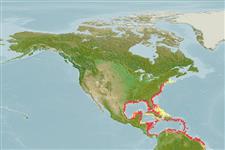Common names from other countries
>
Cyprinodontiformes (Rivulines, killifishes and live bearers) >
Cyprinodontidae (Pupfishes) > Cyprinodontinae
Etymology: Cyprinodon: Latin, cyprinus = carp + Greek, odous = teeth (Ref. 45335); variegatus: From the words Cyprinus=a genus of minnows and odious (stem odont)=tooth, meaning minnows with teeth; variegates Latin for variegated, variously colored (Ref. 79012).
More on author: Lacepède.
Environment: milieu / climate zone / depth range / distribution range
Ecología
marino; agua dulce; salobre bentopelágico; no migratorio. Subtropical; 45°N - 0°N, 98°W - 49°W
North and South America: Massachusetts, USA to northeastern Mexico; and West Indies (Ref. 86798); northern coast of South America (Ref. 5217).
Tamaño / Peso / Age
Maturity: Lm ? range ? - ? cm
Max length : 9.0 cm TL macho / no sexado; (Ref. 27139); common length : 3.0 cm TL macho / no sexado; (Ref. 5217)
A short, deep-bodied, compressed fish. Scales large, dorsal profile straight from tip of snout to front of dorsal fin; dark marginal band on tail (Ref. 26938).
Occurs usually near vegetation in salt, brackish and fresh water (Ref. 86798). Inhabits hypersaline lagoons and connecting channels. Found on muddy bottoms in turbid waters (Ref. 5217). Omnivorous; consuming organic detritus and algae, as well as microcrustaceans, and dipteran larvae (Ref. 79012). Caught with fine-meshed nets. Very abundant and easily reproduced in captivity. Used as a forage fish in mariculture (Ref. 5217). Not a seasonal killifish. Is easy to maintain in the aquarium (Ref. 27139).
Life cycle and mating behavior
Maturities | Reproducción | Spawnings | Egg(s) | Fecundities | Larva
Page, L.M. and B.M. Burr, 2011. A field guide to freshwater fishes of North America north of Mexico. Boston : Houghton Mifflin Harcourt, 663p. (Ref. 86798)
IUCN Red List Status (Ref. 130435)
CITES (Ref. 128078)
Not Evaluated
Threat to humans
Harmless
Human uses
Pesquerías: comercial; Acuario: Comercial; carnada: usually
Herramientas
Special reports
Download XML
Fuentes de Internet
Estimates based on models
Preferred temperature (Ref.
115969): 15.4 - 27.7, mean 26.7 (based on 572 cells).
Phylogenetic diversity index (Ref.
82804): PD
50 = 0.5000 [Uniqueness, from 0.5 = low to 2.0 = high].
Bayesian length-weight: a=0.02188 (0.00833 - 0.05747), b=3.06 (2.83 - 3.29), in cm Total Length, based on LWR estimates for this (Sub)family-body shape (Ref.
93245).
Nivel trófico (Ref.
69278): 2.4 ±0.1 se; based on size and trophs of closest relatives
Resiliencia (Ref.
120179): Medio, población duplicada en un tiempo mínimo de 1.4-4.4 años (Assuming tm<1 and Fec<1000).
Fishing Vulnerability (Ref.
59153): Low vulnerability (10 of 100).
